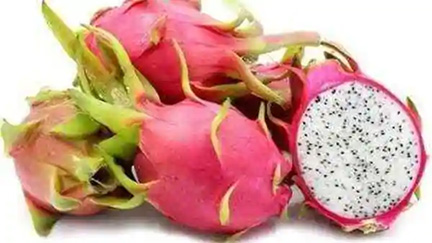Dragon Fruit | 20 Jul 2021
Why in News
In June 2021, India exported its first consignment of dragon fruit from a farmer of Maharashtra to Dubai in the United Arab Emirates.
Key Points
- About:
- Introduction:
- The dragon fruit (Hylocereus undatus) is indigenous to the Americas. It is a member of the cacti family.
- It is also known as ‘Pitaya’, ‘Pitahaya’, strawberry pear, noblewoman and queen of the night throughout the world. In India, it is also known as ‘Kamalam’.
- Climatic Condition:
- It is hardy and grows in diverse climatic conditions with varied soils, especially in the semi-arid and arid regions of India.
- It prefers slightly acidic soil and can tolerate some salts in soil too.
- Flowering and fruiting of dragon fruits coincide with the monsoon season in India (June to November).
- Features:
- Its flowers are hermaphrodites (male and female organs in the same flower) in nature and open at night.
- The plant sustains yield for more than 20 years, is high in nutraceutical properties (having medicinal effects) and good for value-added processing industries.
- It is a rich source of vitamins and minerals.
- Introduction:
- Popularity in India:
- The dragon fruit was introduced to home gardens in India in the 1990s.
- The low maintenance and high profitability of dragon fruits has attracted the farming community throughout India.
- This has led to a steep increase in dragon fruit cultivation in Maharashtra, Karnataka, Andhra Pradesh, West Bengal, Telangana, Tamil Nadu, Odisha, Gujarat and the Andaman and Nicobar Islands, as well as in many north eastern states.
- The country produces approximately 12,000 tonnes of the fruit every year.
- Related Issues:
- High Investment: Dragon fruit is a climber that needs support and hence farmers need to invest around Rs. 3.5 lakh per acre in infrastructure.
- Drip irrigation also adds cost to the initial investment.
- Issues in Flowering: Generally, sunburn is a common problem in semi-arid and arid tracts and it can be managed by providing 25-30% shade either by planting shade-providing trees (such as moringa, sesbania and Melia dubia) or installing artificial shade nets during the harsh summer months.
- High Investment: Dragon fruit is a climber that needs support and hence farmers need to invest around Rs. 3.5 lakh per acre in infrastructure.
- Government Initiatives:
- The Government of Maharashtra has taken the initiative to promote dragon fruit cultivation in different areas of the state by providing good quality planting material and subsidies for its cultivation through the Mission on Integrated Development of Horticulture (MIDH).
- MIDH is a Centrally Sponsored Scheme for the holistic growth of the horticulture sector covering fruits, vegetables, root & tuber crops, mushrooms, spices, flowers, aromatic plants, coconut, cashew, cocoa and bamboo.
- The Ministry of Agriculture and Farmers Welfare is implementing MIDH with effect from 2014-15.

